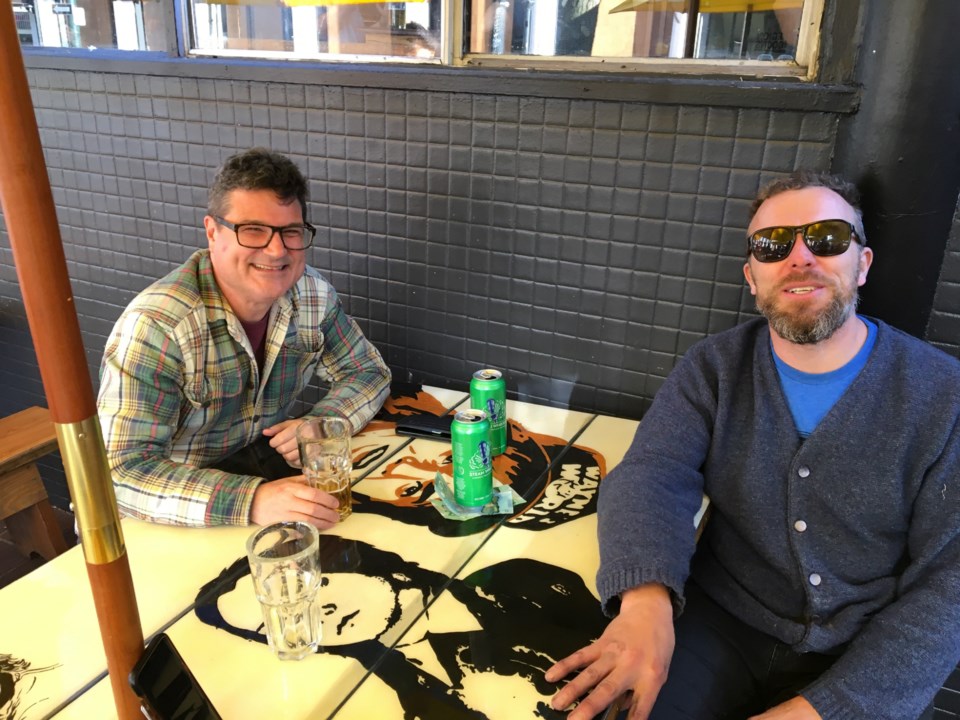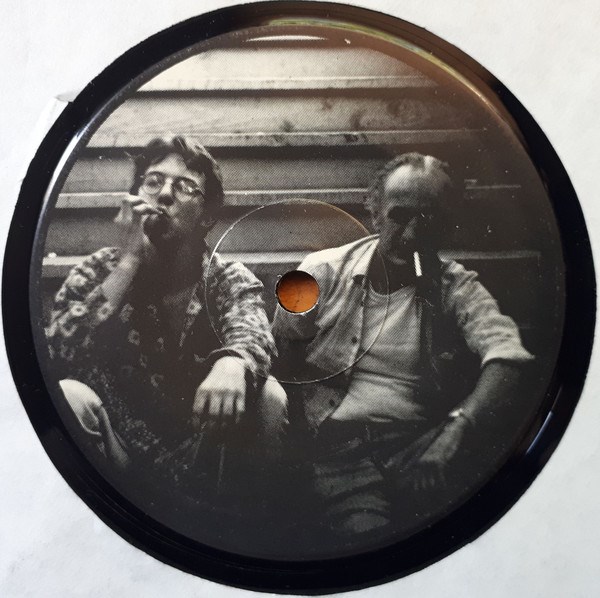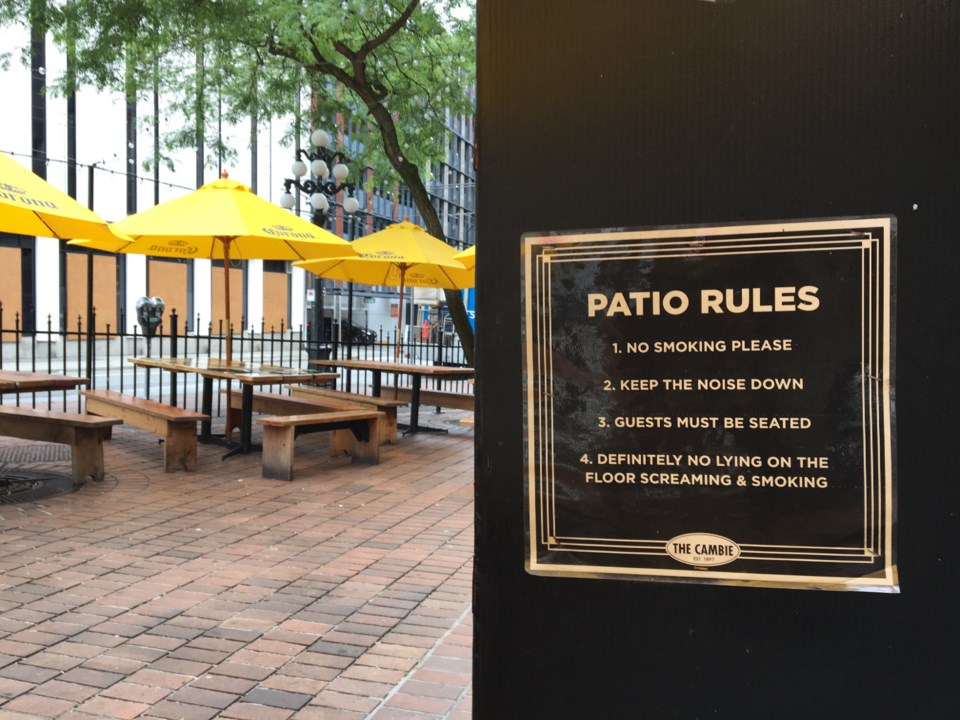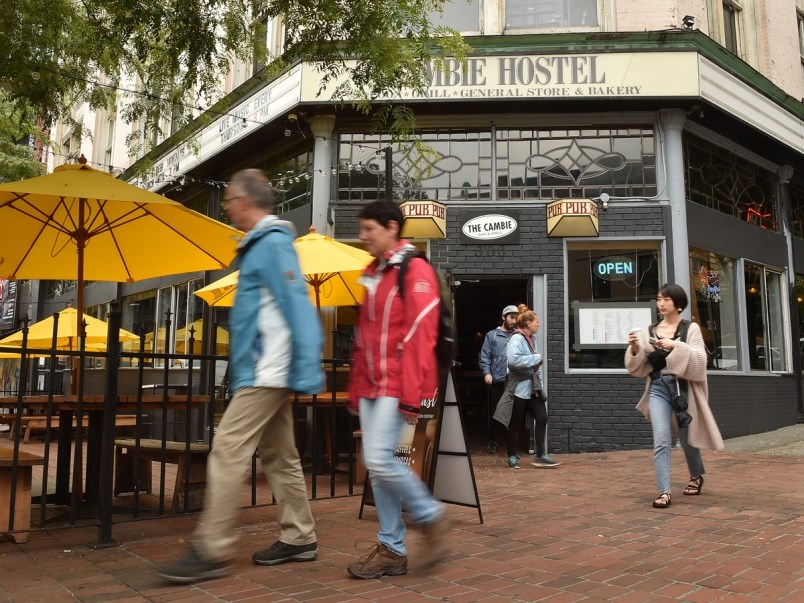“Wanna buy a crossbow? Last in a pack of six!”
That’s what the scruffy hustler was offering, holding open a filthy duffel bag to reveal the single remaining crossbow. We took his offer to mean the other five crossbows might already be in the possession of other soused patrons surrounding us at the Cambie.
That kind of unsolicited, black market table service was commonplace at the Cambie in the late 1980s and early ’90s, when property crime was arguably at an all-time high in the neighbourhood.
“You’d be offered an entire brick of stolen cheese,” remembers my Smugglers bandmate Nick Thomas. “Or packages of raw meat. I recall that the alternate choice to the crossbow was a 25th anniversary sealed VHS copy of The Jungle Book.”
Nick passed on the crossbow. I slipped the guy a fiver for The Jungle Book.
Earlier this spring, many Vancouverites who came of age in the seedy bars just off the Gastown strip were shocked to learn the Cambie, arguably the most legendary and notorious of them all, will be closing this fall after an unprecedented run at the corner of West Cordova and Cambie Streets. The stories came pouring forth like dirt-cheap Molson Canadian.
Youth movement

According to the Cambie’s owner, Sam Yehia, a bar has been in operation on that corner at 310 Cambie St. since 1897. That 132-year stretch makes it the oldest watering hole in Vancouver. Many would say, with great fondness, the key word in that last sentence is “hole.” Over the years, the bar has gone through many makeovers before it became known as the world-famous backpackers hostel it is now.
“The place was a dump when we encountered it in the late 1960s,” recounts Paul Dixon, a friend of a friend who commented on Facebook. “Back then it was called the Gastown Inn, or the ‘Grasstown Inn’ as it was more commonly known. You would walk through on a weekend night and be accosted by the denizens of every second table: ‘grass, hash, or acid?’ That was the mantra of the day.”
By the 1980s, after a stint as the Carleton, the bar was christened the Cambie, and was known as an “old man bar,” a dive generally inhabited by retired or out of work blue collar single men drowning their sorrows, many of whom lived in the surrounding SROs. It was a tough place.
You could make a very strong argument that the fortunes of the Cambie turned around when a tiny, subterranean record shop called Scratch opened up in 1987, directly across the street at 317A Cambie, down the stairs in Vancouver’s only subterranean row of shops. It was owned and operated by Keith Parry, who now lives in his hometown of Courtenay, B.C.
“I was living at the back of the store,” says Parry. “My friend Jim Edgett was living upstairs at Danny’s Inn. We were 19 years old, and so many of the pubs and old man bars of the neighbourhood were rough and intimidating, so Jim and I decided to go to the Cambie as some rite of passage for at least one drink, every day for a month.”
Like many former Cambie patrons, Parry doesn’t mince words when describing his first impressions of Vancouver’s venerable den of sin.
“It was downtrodden. There was a one-man-country band playing to an audience of bikers and drug dealers. Old timers and alcoholics of all varieties lined up at 9 a.m. to get in. Stolen goods were sold table to table to patrons slouched in those yellow, cockroach-infested booths. And it was less than a dollar for a glass of beer.”
Nick Thomas also fondly remembers the cheap suds.
“They came in these little glasses for seventy-five cents each,” Thomas recalls. “Whenever the server would come around to announce last call, we’d say, ‘We’ll take 20, thanks.’”
Up the hill in the late 1980s, Seymour Street had become known as “Record Row” for the stack of records stores lining the east side of the block between Dunsmuir and Pender Streets. A&B Sound was in the thick of it, employing many young music lovers, one of whom was future filmmaker and New Pornographers keyboardist Blaine Thurier.
“The first time I went to the Cambie was in 1988. I was with a friend who I worked with at A&B Sound, and we were the most regular-type people there,” remembers Thurier. “The rest of the clientele were committed Downtown Eastsiders. The place did not feel safe. Going to the bathroom was an adventure, but it felt a lot more exciting than the Railway Club.”
Thurier credits former �鶹��ýӳ��musician Sandy Morris as one of the original trailblazers for the youth movement at the Cambie.
“Long before the trendy crowds found the Cambie, my scene was a group of musician types, drinking away many afternoons and nights at the Cambie,” says Morris, who played in many �鶹��ýӳ��bands, and now lives on �鶹��ýӳ��Island. “When I started going to the Cambie, they still had the circular booths. A glass of beer was seventy-five cents and a pint was $1.75. Roz worked the bar and Ross gathered the empty pint glasses, stacking them high into the air.”
Soon, the scene of indie musicians who gathered at the Cambie would make a lasting impression on the city’s music scene.
“The people who worked at A&B Sound would come down to Scratch to shop,” says Parry. “It wasn’t long until friends and bandmates and Scratch customers would start going to the Cambie with Jim and me, and then it became something that just happened on Fridays. Close the store, meet friends at the Cambie and close the bar down.”
Parry would become the drummer of the proto-alt-grunge band Superconductor, which featured many of his male drinking buddies at the Cambie on six guitars and two basses, while Morris would help form the all-female and equally grungy Kreviss, also featuring many, many guitarists. Several romances existed between the bands.
“I spent many hours at the Cambie in the early days of Kreviss and Superconductor,” recounts Sara Lapsley, the former lead singer of Kreviss, who now lives in Ottawa. “My most salient memory is getting banned from the Cambie for three months because I entered the men’s washroom. I noticed a strange object in the urinal, so I picked it up and carried it back to our table. The bouncer caught up to me and implemented the ban. I had no idea what a urinal puck was!”
Carl Newman was the lead singer of Superconductor, and would eventually form the internationally renowned New Pornographers with his Cambie drinking buddy and best friend Blaine Thurier almost a decade later.
“I remember the first time I went in to the Cambie I felt like a brave explorer,” says Newman, who now lives in Woodstock, New York. “But I didn’t know that every town had a dive bar haunted by hipsters. Those years at the Cambie was the only time I’ve ever had a ‘Cheers’-type place that I could go to anytime and I would know someone. It felt like a place where something was always happening.”
The injection of young, healthy, polite, vibrant, flannel-clad longhairs from the suburbs was a shock to both the beleaguered staff and the wasted, flannel-clad old-timers at the Cambie, many of whom were intrigued at the growing number of scenesters. A few times, contact across the generations was made.
“I remember going to the Cambie once with a friend, and there was nowhere to sit,” recounts Thurier. “A man with a swollen, red, bulbous nose was asleep alone at a large table so we figured he wouldn’t mind. He was also clutching his groceries from Woodward’s, which was still open at the time. He woke up and glared at us, latching on to us with a deep hatred. He snarled at us and spat, ‘What do you know about pizza!?’ I checked his bag and sure enough it was stuffed with frozen pizza. He repeated the question. I thought he was going to knife us, but be promptly fell back to sleep, so we stayed at the table and ordered a six dollar pitcher.”
Here comes a regular
One old-timer from the Cambie who many remember was a foul-mouthed Maritimer named Don Campbell.
“He’d belly-up to our table and sit uninvited, telling us tales of riding the rails ‘from coast to coast on tea and toast,’” says Thurier.
“He’d referred to himself as ‘the meanest cocksucker in the St. John River Valley,’” chimes in Newman.
“Don Campbell lived upstairs above the bar,” Morris continues. “He was a total asshole whose obscenity-filled vocabulary endeared himself to us. He became a regular at our table.”
A picture of Don Campbell can be seen on Superconductor’s 1991 debut single, The Most Popular Man In The World, on Scratch Records.
“By the time we met Don, his face was basically hamburger, and his voice already carried a permanent death rattle,” says Thurier, who also featured Don in one of his indie-comic zines. “He did like the young men though. Don hit on each one of us in turn. I always felt bad for him. He carried around this impossible, unfulfillable desire. Of course, the pity stopped as his perseverance became annoying. Our friend Sean Condon did end up in his room once, but not for sexual purposes. Don locked the door and cradled Sean’s face in his hands and said, ‘Are you gonna make love to me?’ Sadly for Don, the answer was no.”
Condon was another music-loving kid from the suburbs who shopped at Scratch and was soon crossing the street to the Cambie to join the alt-rock drinking crowd. He’s pictured beside Don Campbell on the Superconductor single. Condon now lives and works in Langley.
“Yeah, both the Cambie and Don Campbell are somewhat indelibly etched in my mind, for several factors,” says Condon. “Don was actually a really nice, gentle guy. He sat in that bar every day. He was a very cheap drunk and became utterly intolerable within about three or four pints. He had some particularly deep and long scars across his face, but he had a soft look. But I did once see him get clocked by a large lady who literally just walked through the door. Don lurched at her, and she floored him with one punch.”
Just another day at the Cambie.

Secret’s out
Parry remembers exactly when the scales began to tip from old-timer dive bar to its current endangered status as full-blown international youth hostel party bar.
“Here’s how it all went wrong,” recalls Parry. “A friend of mine invited his friend Boyd, who was a bike courier. Boyd loved the crusty experience of the Cambie. Up until then, it had been our little anti-hipster secret, but the very next weekend about 50 bike couriers invaded the place, and suddenly the Cambie was no longer our secret.”
The turning point was also helped along by larger happenings in the music world. By 1992, grunge had broken and the alternative was mainstream. Thanks to that cheap beer that initially attracted the vanguard of Vancouver’s indie rock scene, the owner of the Cambie suddenly had a golden egg of a grunge bar on his hands.
“Renovations happened, the one-man-country band turned into a grunge jukebox, slovenly, lecherous old timers like Don Campbell were evicted from the upstairs hotel so it could become a youth hostel, and for some reason, people started lining up to get in, which seemed bizarre to us, because the Cambie was a shithole,” says Parry. “But it was an appealing shithole to us for the weird things that happened there, which all went away when the salty characters were soon nowhere to be found.”
“The young long hairs started showing up more and more until they made up most of the clientele,” says Thurier, who by then was working across the street at Scratch Records. “The older alkies living in the SRO above weren’t too happy, but there wasn’t too much they could do about it.”
The Cambie attempted a complete makeover in 1992, briefly rebranding as the James Dean Saloon, yet another odd blip in the bar’s long history that very few people remember. Luckily, the Smugglers filmed the short lived signage for our 1992 video “�鶹��ýӳ��B.C.”
The bar would soon revert to the Cambie and has remained so ever since.
“Yeah, the bike couriers started showing up and that was the end of it,” Newman says. “Lineups down the block, and no special privileges for early adopters.”
Johnny McQueen has been a �鶹��ýӳ��bike courier since the early 1990s, and claims the couriers didn’t take up residency in the Cambie for long.
“Yeah, we hung out at the Cambie for a bit,” confirms McQueen. “I remember the noise and the smoke. Endless pitchers of cheap draft and those huge tables made out of old bowling alley. But the couriers had our ‘own’ bar to hang out at, which was the Niagara and later the Brickyard. Mostly I remember the atmosphere of the Cambie. A lot of good times.”
Foggy memories

For the past nearly 30 years, the Cambie has been a roaring drinking establishment, adding a large patio, a bakery and the famous “burger and a beer” deal. When the announcement of the bar’s closure came down — which supposedly has something to do with the — social media became ablaze with ridiculous remembrances.
One person claimed that standing beside that grunge jukebox meant you wanted to buy drugs. Another suggested the draft beer was piped in from the urinals. One person met her husband during a binge at the Cambie and they now have two kids. Another fondly recalled how the bar smelled like “warm vomit.”
No matter what the memories or the era, what is for certain is that the Cambie, a place that often felt like a sloppy, dangerous, lovable cross between an old west saloon and the cantina from Star Wars, was indeed a rite of passage for countless Vancouverites for more than a century.
And that salty old timer Don Campbell?
“I remember opening Scratch one morning, right across the street from the Cambie, and I could see Don peering down at me from his window above the bar,” recounts Thurier. “I had never seen such despair. It was like a ghost looking at me from a lonely, desolate hell. Years later, I heard that Don was found dead in another SRO, his throat cut, having hit on the wrong guy.”
The Cambie will pour its final round Nov. 30, 2019. If you return to pay your respects to the oldest bar in this town, be sure to raise a glass to the Cambie’s barstool ghosts like Don Campbell.
��
��
��
��
��
��
��
��
��
��
��
��
��
��
��
��
��



